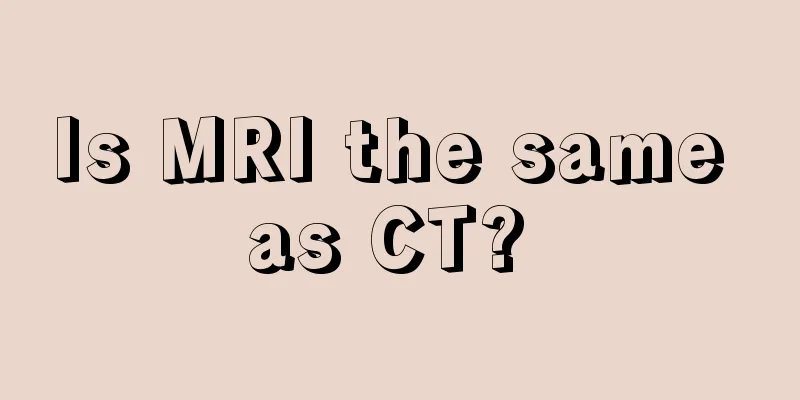Is MRI the same as CT?

|
The structure inside the human brain is extremely complex, and there are many diseases in the brain, such as the well-known cerebral congestion, brain abscess, and brain tumors. These diseases can cause similar symptoms in patients, such as dizziness and headache, etc. Therefore, in order to diagnose the disease, patients need to undergo scientific examinations, such as MRI examinations. So, is MRI the same as the CT examination that everyone often talks about? Is MRI the same as CT? MRI does little harm to the human body, while CT uses X-rays to examine the human body and produces radiation. Generally speaking, MRI tends to examine soft tissue, while CT tends to examine hard tissue (bone tissue). The examination should be based on specific circumstances. MRI has high soft tissue resolution, and MRI may be performed again if CT is not clear. If there is ferromagnetic metal in the body, it will affect MRI imaging, and if the metal moves in the body under the influence of the magnetic field, it will also cause damage to the human body. CT is a planar image (slice) of the human body, while MRI is a three-dimensional perspective image. If the location of the pathology cannot be confirmed, only MRI can be used. If it can be confirmed, CT will be enough. You cannot have an MRI if there are metal parts in your body. Just imagine the huge magnetic field. Anyway, the principle of CT is that the reflection time of X-rays is different to form an image. MRI is another major advancement in medical imaging after CT, so what is the difference between the two? MRI: It is water proton imaging, which uses an external magnetic field to change the spin direction of electrons around water protons, and then produces proton imaging based on this principle. So far, no clear harm of MRI examination to the human body has been found. CT: It is a density imaging. After X-rays penetrate the human body, due to the different densities of different tissues in the human body and different absorption rates of rays, an image with different density is produced through the post-processing system. The advantages are fast inspection speed and good density resolution, but the radiation is harmful to the human body. MRI examination precautions MRI examinations last a long time, are very sensitive to human movement, and are prone to artifacts, so they are not suitable for emergency and critically ill patients. During MRI scanning, the noise in the chamber is relatively high, so patients need to cooperate closely and remain calm. MRI, as a new imaging technology, will not affect human health, but six types of people are not suitable for MRI examination: 1. Even if you have a pacemaker installed; 2. People who have or are suspected of having metal foreign bodies in their eyes; 3. People who have undergone silver clip ligation for aneurysm; 4. People with metal foreign bodies or metal prostheses in their bodies; 5. Critically ill patients whose lives are in danger; 6. People with claustrophobia, etc. |
<<: What is the effect of standing for half an hour after a meal?
>>: What is the clinical significance of enhanced MRI?
Recommend
The cause of colorectal cancer is something that patients must understand
Colorectal cancer is a relatively common disease ...
What are the effects and functions of silkworm sand pillow
Pillows are essential bedding for our daily sleep...
The efficacy of rice worm
Speaking of rice bugs, do friends who love food t...
Can cutaneous fibroma be treated with cryosurgery?
Dermatofibromas can be removed through cryosurger...
Effects of alcohol on muscles
Many people usually have the habit of drinking. A...
What is the reason for sweaty scalp
Nowadays, many people's scalps are always swe...
How to treat erythema on the back
Many patients will scratch with their hands when ...
Women's nightmare! 4 symptoms of advanced ovarian cancer
Symptoms of late-stage ovarian cancer include abd...
Note: Symptoms of female uterine cancer will gradually develop into uremia!
Symptoms of uterine cancer in women are common gy...
How to control your heart rate during aerobic exercise to lose weight?
In modern life, people have regarded obesity as a...
How to quickly recover from scratches on the face
Many people scratch their faces with their hands ...
How much blood does it take for a person to die?
In our daily lives, we always have some small bum...
How to promote blood circulation
We all know that food contains many nutrients tha...
Can thyroid cancer be cured by surgery
Due to the influence of traditional concepts, man...
What is the difference between eyebrow tattooing and eyebrow shaping
Eyebrow tattooing and eyebrow trimming are both m...









